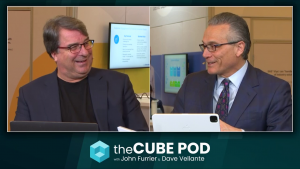Rackspace looks into the future of cloud, open compute | #OCPSummit15
Aaron Sullivan, a distinguished engineer at Rackspace, Inc., believes there are still improvements to be made when it comes to cloud and the stack, and that Open Compute will spark those innovations. He sat down with theCUBE co-hosts Jeff Frick and John Furrier at the recent OCP Summit to talk about Rackspace, the role of Open Compute in upcoming advancements, and the psychology of the in-the-trenches developer.
What Rackspace learned from building OnMetal
When Rackspace started to build the cloud-based OnMetal service, Sullivan described their thought process as a “need to design a service that gave people bare metal cloud at hypervisor-cloud-provisioning-and-security-type speeds and feature sets.” Without a hypervisor, Sullivan explained that Rackspace had to “do things in the firmware of the server to replace some of those core functions and safety mechanisms.” While Open Compute engineer engagement helped Rackspace “get there,” Sullivan acknowledged, he also said that Rackspace “hit a wall.” There were limits to “where we could take open on the platform were were on at that point in time.”
In response to the difficulties Rackspace faced, Sullivan said he thinks cloud still has a ways to go: “We think the cloud is going to continue to evolve and need to get vastly more efficient than where it is today.” The best way to accomplish this evolution, Sullivan suggested, is to get developers “deeper down into those systems.” And the best way to get developers deeper? “Just open the whole thing up,” he stated emphatically.
Psychology of the In-the-Trenches-Developer
When developers first get access to Open Compute, their “eyes are popping out of [their] heads,” said Sullivan. But as time goes on, openness becomes “the new normal” and developers begin to “feel much more empowered.” At the same time, though, “it changes the playing field,” he said, because “they know everybody else can be that much more creative and innovative as well.” Savvier competition means developers need to step up their game and begin looking for new potential.
The formation of a new stack
One area in particular where Sullivan sees such potential is in the stack — and not just the “software defined stuff,” he said. Sullivan sees “a new stack forming” as software defined network, software defined data center, and software defined storage” slowly become “real products that people want to use.” But he sees room for “some really radical changes down at the bottom of that stack, in the chips and servers.” He expanded, saying, “if we rethink the stack all the way down, we can get a great deal more efficiency and flexibility than what we have today.” The “software defined stack wars today” are just a symptom of larger things to come, he suggested, like “servers that are extremely vertically integrated but also open.”
“We’re past the purpose-built start line.”
When it comes to the purpose-built trend, Sullivan said that he thinks “we’re past the start line.” The demand from customers and end users for “ever more efficiency and performance,” and for scale and ease of creating an app is “relentless.” This demand, he added, “forces you to evolve to stay relevant and keep giving customers what they want.” And part of that is workload-centric tuning.
In the past, he continued, it was easier to give customers higher performance with new generations of systems. Now that that’s “slowing down,” companies need to “keep looking for other ways to squeeze more value out of the system.” said Sullivan. By offering purpose-built stacks crafted from open source technology, Sullivan said that it forces developers to “burn [their] boats.” There’s no going back in order to create value, instead, “I have go to do the next big thing.”
One of the “next big things” Sullivan predicts will emerge is “middleware for those very advanced purpose-built systems.” As value shifts to applications, providers will follow with services and support. Customers will eventually need to run their apps at massive scale, said Sullivan, and will turn to companies like Rackspace for “the best cloud and the best integration service to run their application.”
Watch the full interview below, and be sure to check out more of SiliconANGLE and theCUBE’s coverage of OCP Summit 2015.
A message from John Furrier, co-founder of SiliconANGLE:
Your vote of support is important to us and it helps us keep the content FREE.
One click below supports our mission to provide free, deep, and relevant content.
Join our community on YouTube
Join the community that includes more than 15,000 #CubeAlumni experts, including Amazon.com CEO Andy Jassy, Dell Technologies founder and CEO Michael Dell, Intel CEO Pat Gelsinger, and many more luminaries and experts.
THANK YOU













